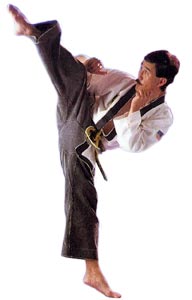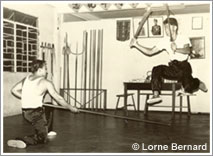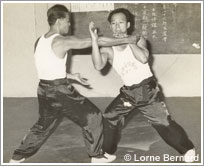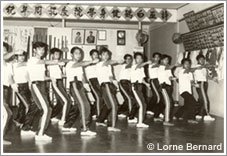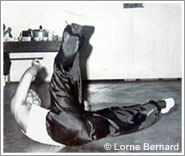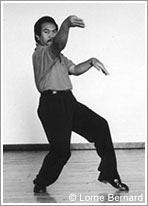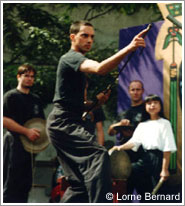by Gary J. Clyman(This article was completed 5 years before the Sash Testing and Ranking System was created. Please see that section for rank qualifications and requirements.)
If "Internal Power" is what makes Tai Chi Ch'uan special, then why is it the best kept secret in the martial arts?
The purpose of this article is to give readers a Grand View of Tai Chi Ch'uan including a understandable description of what the word "internal" really means when used to describe the high level of achievement possible in Tai Chi Ch'uan. The system I am describing is Temple Style Tai Chi Ch'uan which I began studying in 1974.
When people practice what they call Chinese "internal" arts, all teachers have their own interpretation. Most of the articles used to describe what Chinese internal arts have left me hungry for a definitive answer. This is my attempt to fill in the blanks.
Many transformations that take place inside the body. This is what makes an art Internal. Internal Energy is stored for latter use. The difference between an "internal" art and an "external" art is an "external" art is visible to the untrained eye. That means you can actually see what the actual technique is by the way it appears. For example, a external punch is usually one single long movement. However, when we are describing "internal," we are talking about the transformations that take place inside the body. It is as if the body is the gun and the Jing (Internal Power) is the bullet.
THREE BASIC CATEGORIES OF FAH JING (EXPLODING POWER)
There are three basic categories of Jing: Long, Short, and Cold. Long Power consists usually of one long vibration similar to the motion of a garden hose when shook once. Short Power consists of many vibrations crammed into one small space. Short Power resembles the inside of a laser tube. The vibrations bounce back and forth without leaving their confinement. Cold Power consists of many vibrations that don't take up much space but usually move horizontally and vertically. Cold Power looks like what happens when you throw a bucket of water against a wall. The water moves horizontally and vertically. With Cold Power there is usually no perceivable penetration.
Long Power is usually painless. The person receiving Long Power usually feels nothing at the point of contact, that is, until they hit an unmovable object like a wall or the ground. Long Power has been described as feeling like you were hit by a truck. Believe it or not, Long Power is the "friendliest" variety of Jing.
Short Power usually hurts. The vibrations go too fast for the receiver to neutralize. That means the tissues receiving Short Power could get damaged. People don't like getting hit with Short Power. Short Power is not friendly and can be used to break your opponents will. Short Power possesses the variety of expressions.
Cold Power is used to knock an opponent silly or unconscious. Concussion or shock is the usual outcome of being hit with Cold Power. Cold Power can overload the central nervous system of your opponent and end an altercation immediately. Cold Power feels like you ran into a wall that you didn't see. Permanent damage can result from using this nasty application of Fah Jing. I have been in fights that have lasted only one punch because of Cold Power. Cold Power releases the most energy in the smallest possible space.
There are many variations and expressions of this so called "bullet" or the Jing. Many different variations of Jing and still within Short Power has the most possibilities for expression, so what we have here, is an internal art. When I want to transfer power, I decide what kind of frequency and what speed the vibration will manifest prior to the expressions of the technique or internal power. Then I release my Jing. Not only do you have five element flavors; fire, earth, water, metal, and wood, you also have any kind of design of the vibration that you want to create. It's like bouncing a basketball on the floor, which is "bounce" power or driving in a screw which is "twisting" power, just to name two.
You have all these different variations of Fah Jing otherwise known as Exploding Power: the way that Jing can be expressed. No one ever tells you how you do that, what processes do you go through, or what steps you take to develop the ability to release internal power. Then when you develop the ability to release internal power, how do you develop the ability to hold it or change the frequency to the type of vibration you wish to let out. No one ever told me how, I practiced it for many years, 6-10 hours a day before I figured it out.
It's important to understand, you don't begin as an external practitioner and then suddenly switch to be an internal one. You begin internal and just get better!
When I hit somebody and let out the various frequencies and flavors of Fah Jing, "What are you letting out?" is the question. Not, how do you do it? If you understand the concept of what you're letting out; how do you do it is very simple.
How do you flavor what you let out? First, you have to have developed the ability to suck. You don't get that from doing forms. You get it from practicing Chi Kung or doing what I call "The Tai Chi Connective Meditations." You have Chi Kung which is one aspect, and Tai Chi, the other aspect. Tai Chi gives you the structure. You will find the answers in my Tai Chi structure where all the meditations in the entire system are outlined.
The commodity of energy and cultivating internal energy in yourself comprise step one. Step two is transforming your Chi, which is your cultivated internal energy into cultivated internal power, which is your Jing. So one is your Chi and one is your Jing. Chi you feel and they don't, Jing they do feel. So a lot of people have Chi (Internal Energy), but very few people have Jing (Internal Power). Cultivating this internal power requires special training. We are talking about modulating the amount of Jing and varying the type of frequency that the Jing manifests.
How do you do that? Is it all here in the mind, pointing to one's head? This commodity of energy that you circulate in your body is an exact reflection of your WILL. And your WILL therefore is a direct reflection and extension of your cultivated sexual energy. That's why when you have sex, you don't want to ejaculate.
When you cultivate your internal energy (Chi), the goal is to transform it into Internal Power (Jing), you express your Jing in your life or through applying these energy principles through Fah Jing (Exploding Power). Fah Jing is directly related to your ability to condense. You can modulate or alter your frequency as well as the amount of energy you let out. The important thing to understand here is "when you practice this and you cultivate internal power, it is the kind of thing that can be released from your body without you losing any when you release it." That's why when I hit someone, I don't get tired. But also when I hit someone, I remain intact, and the energy that's released on contact remains my energy in their body. You must invest years practicing condensing breathing before you can do this. What's reflecting here is your ability to create your internal vacuum which will be directly related to your ability to explode.
I'm not trying to make it sound like not ejaculating is the same as cultivating Jing, it's not, but not ejaculating is an important step in cultivating Jing. So you have this commodity of energy that stays intact in your body. After you can circulate this commodity of energy as a capsule throughout your body, the question is, "How does this set you up for being able to release your Jing outside of the physical boundaries of your body to use it in some other space?" Now we are talking about real Jing (Internal Power).
When you cultivate Jing, you develop control of where your energy is packaged in your body. When I hit you very gently, I release the vibration in the form and flavor that I choose the vibration to be. I determine what that vibration will look like. I can draw it on paper and give it to you and you will draw the same picture of the vibration. That is the kind of control that can be developed. But before you can even think in terms of releasing energy with a specific frequency or modulation, you must cultivate it first.
How does your Jing fit in with a business transaction? Your WILL is a direct reflection of your Jing. You do not cultivate energy when you need it you must cultivate energy before you need it. You must have energy already stored. You are going to use "stored energy." Your WILL is a direct reflection of your amount and ability to circulate cultivated sexual energy you possess. So if you practice in the morning and feel alive, you are not going to be a wimp in a business environment. Shen is your level of assertiveness in the world. I have the ability to transmit my internal energy to someone else over distances if I've already worked with them. When I touch you after you've learned Chi Kung from me, you will pick up the vibration from me, then you convert it into yours. When you sit back to back with me, you're getting my energy to circulate throughout your system until you have practiced enough where the energy that I've transfused to you has been adopted and accepted as yours. A little bit of me always stays within you. For instance, if you are under stress, I go back and rev up that piece I left behind.
First you cultivate Chi. Next you transmute Chi into Jing. What we are referring to here is the various expressions of Jing (cultivated sexual energy or Internal Power). There is a difference between Internal Energy and Internal Power. Internal Energy is Chi, Internal Power is Jing. Jing can look like lightning, a whirlpool, or it can look like bouncing a basketball. These are all various expressions of Jing. What do you cultivate or generate to develop the ability to express these specific frequencies and modulations of energy? I am talking about cultivating this golf ball that is moving around under your skin from practicing Chi Kung. You move your WILL inside your body freely. After that has been accomplished, you can then allow your will to leave your body while also still remaining in you. A tiny part can leave which can then be vibrated into another person. The sensation that you can feel, you can eventually shoot. You can separate it from you yet still stay in contact with it. The golf ball that moves under your skin is what you shoot out into the other person. This information has been kept quite a secret. Many authors write about it, but few can actually perform it. This high performance level is one of the major goals of Temple Style Tai Chi Ch'uan. The Seven Levels of Mastery will describe what is involved in becoming proficient in Temple Style Tai Chi Ch'uan. Cultivating your vibration is the main purpose for learning and practicing Temple Style Tai Chi Ch'uan.
THE 7 LEVELS TO MASTERY
LEVEL #1 DESCRIPTION
Level #1 in Temple Style is geared toward creating a strong, yet fluid foundation. In the beginning of the system, during the first year, your Tai Chi must be carefully and patiently practiced. You must allow enough time between learning new forms for your body to change, structurally. Many new Tai Chi students have no idea how frozen and immobile their hips, knees, ankles and other joints actually are. The Foundation Fundamentals (available on video) appear simple and easy while watching, but are extremely difficult and may even appear impossible to perform correctly at first. Beginning Tai Chi students should spend enough time on each form and not be concerned with getting to the next form. Your body will make the necessary adjustments and you will successfully move through the system by concentrating on The Foundation Fundamentals.
Level #1 is not restricted to only Foundation Fundamentals. After creating a foundation to build upon, you will soon begin to learn new material at a faster, yet appropriate rate. Level #I contains all the forms up to and including the construction of The First Section, right and left sides. The Two Person Practices are also taught from the very beginning and will be emphasized throughout your Tai Chi training.
Unlike many other Tai Chi methods, Temple Style encourages learning all the forms on both sides. This feature is and will become even more important in your Tai Chi future. By the time you complete Level #1 in Temple Style, your body should have changed considerably. Your joints will function more smoothly and securely. Your posture will be corrected considerably. You will be breathing more fully in a coordinated fashion, and you will develop a new way to move using your whole body and become firmly rooted to the ground. There may be many other benefits as well depending on your level of health.
This first part of Temple Style training should not be skimmed over. You must realize that your Tai Chi future is based largely on your first year. Be patient and careful not to skip a single detail during your first year. The first year is also your hardest. If you neglect anything in your first year, it will reappear to haunt you until you have successfully repair it.
LEVEL #2 DESCRIPTION
Level #2 begins with a new method of practicing Pushing Hands called "2 Hand Pushing Hands" incorporating Ward Off and Push as a two person practice. Your hips must move fluidity in order to perform 2 Hand Pushing Hands correctly. This takes a lot more work than is apparent. You will then begin learning the Individual Forms that are included in Second Section. Again, being thorough and patient cannot be over emphasized. I do not want learning Second Section to sound like an extension of First Section. It isn't.
Second Section builds on your Temple Style foundation and introduces more variations to your movements. Diagonal and more difficult movements will be introduced and incorporated thus making it obvious how hard you worked while learning First Section. These new kinds of movements will stress your joints differently than the more basic moves in First Section.
The Breathing Training taught at the end of Second Section is important in giving you more endurance, control, and extension of your breathing. This is the only time in Temple Style that this kind of breathing training is taught, so you must successfully and competently be able to perform this breathing training. The breathing training in not related to meditation or some sort of internal power development. It is clearly practiced for endurance purposes only and should not be skimmed over. You will never see this again, so don't skip over this.
It will be clear that you are unable to learn and practice Second Section without first absorbing First Section. Level #2 includes everything up to and including the completion of Second Section.
LEVEL #3 DESCRIPTION
Level #3 contains, completes, and connects the remainder of The Long Form. The primary components of Level #3 is Third Section. However, in this level, a large percentage of the material is dealing directly with the aspect of Tai Chi martial art applications. Fair Lady Works At Shuttles is the main Third Section addition and introduces Upward and Downward movements combined with diagonal movements. Roll Hands, 6 Kinds, is an extremely important subset and must be practiced totally as a unit. Do not pick and choose which ones you like more. All 6 must be practiced equally to insure equal proficiency. These Roll Hands Parts are in preparation for Methods of Roll Hands in Level #4. 5 Style Steps and all its variations is of great importance in the big picture since 5 Style Steps can be combined with nearly every other form. In a fighting situation or while practicing your Two Person Practice, smooth 5 Style Steps will prove to be invaluable.
LEVEL #4 DESCRIPTION
Well, now that the form is done, that means that your Tai Chi is done also? Right? No way! Now the fun begins to start. In Level #4, you will learn some of the most potent Two Person Practices that will give your Tai Chi the hormones it has been lacking. We start with 4 Forms Pushing Hands which gives you applications for using Ward Off, Roll Back, Press, and Push. Temple Style has a very specific order and structure for learning and practicing all the Two Person Practices. It is important not to skip any of these specific practices. There is one video that contains all these Two Person Practices. Don't skim over any of them. They all lead somewhere.
Next in Level #4 we come to what is named Temple Style Martial Art Foundation Forms. This subset is important because it helps create the physical structure and connections you will need for utilizing your internal power in a martial art situation. Again, this subset should be practiced in its entirety to assure even progress.
Now we come to one of the two most important subsets in Level #4. This is called Methods of Roll Hands. These 5 Roll Hands Parts will be responsible for you developing great instinct and ability when performing any Two Person Practice with either your best friend or a total stranger who only speaks a foreign language. You get these down pat, and you can deal with nearly any situation without hesitation. This subset is in The Top 5 Important Subsets in the whole system.
Next we come to the Making Chance subset which teaches you how to apply the various Tai Chi forms to your roll hands practice. This subset will be valuable to your Tai Chi fluidity latter when you start performing Free Style Roll Hands. Condensing Breathing traditionally is introduced at this place in the system approximately 2 and a half years into your Tai Chi practice. Condensing Breathing is taught Personal Power Trainingx and on my Tidal Wavex Chi Kung video program. Condensing Breathing is the single most important factor and principle in Temple Style Tai Chi Ch'uan. It changes not only your Tai Chi practice but your life. No kidding. Practicing Condensing Breathing will give you an internal vacuum that is responsible for packing 18 inches of movement and power into one inch of space. Condensing Breathing is in The Top 5 Important Subsets in the whole Temple Style system.
After Condensing Breathing has been practiced sufficiently, another extremely important subset is introduced call Basic Path Training which contains the mind training in Preparation, Beginning, Upward and Downward, Inward and Outward, Raised Hands Stance, Tai Chi Stance, and Slanted Flying. This Basic Path Training subset is so important it is also taught in Personal Power Trainingx and on my Blue Sub-set video.
Now we come to a favorite part of Temple Style; First Section Low Stance Training. This is an extremely difficult part of the system but has enormous benefits when practiced sufficiently. First Section Low Stance will give you strength like you have never imagined in the lower half of your body. After practicing First Section Low Stance over a period of time, all other practice will seem much easier in comparison. This is practiced to raise your endurance. You will practice First Section Low Stance forever. It will never become easy. Make sure you keep it that way.
LEVEL #5 DESCRIPTION
By the time a student has completed the first four levels, more attention is paid to developing a higher ability to develop and utilize Jing or Internal Power. Soong, Hwa, and Bii Jing are specific explanations of the 3 different ways to express Jing or cultivated internal power. It is important to understand that Soong, Hwa, and Bii Jing are recognized by the user and are extremely difficult to distinguish and quantify without expert level Tai Chi skill.
"Soong" Jing translates from the Chinese as "loose." By this, I mean Loose in its truest sense of the word. Loose should be interpreted as Zero, or nothingness. In applying Soong Jing, Tai Chi students should practice being insubstantial or as "not there" as possible.
"Hwa" Jing translates from the Chinese "to make heavy or thick." Use the image of moving your hand in a bathtub full of Jello. Hwa Jing is used to make your opponent increase his effort, while you can control him by using your mind, not strength. A Tai Chi practitioner of greater ability can easily confuse his opponent into increasing his use of strength while he has the ability to decrease his own. In applying Hwa Jing, Tai Chi students should increase their resistance without relying on force. The difference between Hwa Jing and force can be detected by an expert's eye.
"Bii" Jing translates from the Chinese as "quick acceleration." This quick acceleration applies to your Tai Chi Two Person Practice. Your ability to increase your velocity, without relying on strength, is the true use for Bii Jing. It is important to note and understand that Bii Jing exists only before the actual contact with the other person. Once you make contact with your opponent or practice partner, Bii Jing turns into Fah Jing.
Next in Level #5, we come to the Change Door Forms. These forms are important in helping you to develop mobility in general. These Change Door forms are related to your martial art forms practice. This gives you the ability to completely change your position thus giving you all new targets and protecting yours.
Ta Lu is the introduction of your diagonal Two Person Practices. When learning Ta Lu, you will be taught how to use the forms of Roll Back, Lean Forward, Split, and Roll Pull. Learning and practicing Ta Lu will give your Tai Chi the ability to move your whole body as a single unit while doing your Two Person Practices. This also will have direct reflections on your martial art ability. (Brown Sub-set video)
Meditations in Methods of Rolling Hands Forms cannot be over practiced. These meditations will add life and substance to your Two Person Practice as well as to your martial art ability. These new meditations are a direct extension of Methods of Rolling Hands that you learned in Level #4 (Two Person Practice Video). There is a prerequisite to learn these meditations. Each Tai Chi student must be extremely proficient in the Methods of Rolling Hands subset. Practicing this meditation subset will significantly improve your Two Person Practices and your martial art ability. Spend as much time as you can designate to perfecting this subset. It will be some of the most productive Tai Chi time you can invest.
Non-Arms Training is a subset where you learn to use your body as though you have no arms. It consists of evasive whole body movements as well as trapping practices. After satisfactorily performing and practicing Non-Arms Training, your arms will be reinserted back into your Two Person Practice. This is the only place you will spend time practicing Non-Arms Training, so be careful not to skim over it.
Now we come to Fah Jing Training. Fah Jing Training is the releasing part of all your Condensing Breathing and Tai Chi Connective Meditations. Most students at one time or another ask the question, "What do I do on the exhale?" Now comes the time to pay attention to the release part of most of your meditations that you've learned up until now. I hope you have been seriously accumulating energy for a long time, you'll need it.
Fah Jing Training is how you will learn to convert many of your Tai Chi forms into your martial art applications. Each specific form has its own Fah Jing practice. Take your time and get these right.
At this point in The Temple Style Tai Chi System you will be taught the difference between Long, Short, and Cold Power Fah Jing. Each one of these different powers have different vibrational frequencies. Long Power Fah Jing resembles the movement of what happens to an empty garden hose when you give it a solid single shake. Short Power Fah Jing resembles the movement of a jig saw when you are cutting a piece of ply wood. Cold Power Fah Jing resembles a firecracker explosion. In this I mean it seems to come from nowhere and cannot be detected until it appears. No telegraphing. I will now explain each individual power in a general sense. Please remember that each Fah Jing can be expressed in nearly any Tai Chi form, but some are easier than others.
Long Power is the practice of releasing one single vibration and sending a person flying across the room. Long Power Fah Jing is usually performed with a wall or backstop behind the person being propelled. The backstop is important for the other persons safety. Without the backstop, you run the risk of the propelled person falling and getting injured. You want to avoid this at all costs. I like using very hard wood walls or solid wood doors for demonstrating Long Power. Concrete is too hard and can do structural damage to the other person. If no backstop is available, I advise not practicing Long Power Fah Jing. Wait until the situation is more suitable and never practice Long Power on a fragile person, they can be hurt by accident.
Short Power Fah Jing is the practice of releasing a huge amount of energy and vibrations in a very small space. There are very little space requirements in order to perform Short Power effectively. You can utilize the space inside your practice partners own body. This is different than the practice of Long Power Fah Jing. In Long Power Fah Jing your practice partner must have room to fly backwards. In Short Power Fah Jing your practice partner requires very little space.
Cold Power Fah Jing again is a very specific way of releasing energy and vibrations. However, when performing Cold Power Fah Jing, your practice partner or the person you are demonstrating on, must be prepared for an intense and surprising shock. Not an electrical shock, it's more like getting hit by a car and never knowing it is there until it is too late. Again, Cold Power Fah Jing requires absolutely no space to perform. Cold Power Fah Jing may also be performed in almost any Tai Chi form and it utilizes shock or concussion, so you need a resilient practice partner.
Practicing Long, Short, or Cold Power Fah Jing in the beginning will appear somewhat crude or rough. You must have patience and faith that you will soon begin to see results. The first time I used or rather it used me while I was practicing Rolling Hands was in 1977. I dumped one of my seniors who had been considered better than me since the start of my Tai Chi training. However, we were both extremely shocked when something unconsciously came out of me and he landed on his head in a deep puddle of water from recent rainfall. I don't know who was more surprised, he or I. I was in Temple Style Tai Chi about 3 years when this happened the first time. Shortly after that, I developed more control of my internal power and eventually began to be able to use my Fah Jing at will.
Now we come to some specific directional meditation practices called Sink Jing and Uproot Jing (Brown Sub-set video). These two Jings train you in sending your mind in single directions, namely, straight up and straight down. The practice of Sink and Uproot Jing does not require the use of any specific Tai Chi forms. Rather these are done in your basic Beginning Stance. Sink and Uproot Jing practice will give all your Two Person Practices more thickness and the ability to control your opponent.
We have now completed Temple Style Tai Chi Ch'uan Level #5.
LEVEL #6 DESCRIPTION
Level #6 starts out with the various applications of internal power (Jing). There is only one simple way to describe the concept of En-Jing and that is to slam a door. You close the gap on your opponent and leave no space for any additional movement. This is not only a physical technique but also a psychological technique.
Next is Control Power which is exactly what is sounds like, controlling your opponent. Jie-Jing is to borrow the other persons energy and hold them in place.
Next we come to the precursors for Gold Bell Training which is developing the ability to take and repulse a punch from an opponent. Gold Bell Training is also sometimes known as Iron Shirt, only the translation is different. When learning Gold Bell Training, you start with relatively light pressure and accelerate it to full contact. (See IKF Magazine article #2 for details.)
Our next practice we come to is San-So and all the various applications. San So is directly related to your martial art practice. There are literally thousands of variations in techniques. This will help your free fighting.
The next section we come to is Low Stance Training. Here you will get a chance to practice some of your favorite Tai Chi forms, but not in your favorite way. You will use Low Stance. Hang in there, you will eventually get good at this.
In Temple Tai Chi Ch'uan, Chi In Voice And Action is very important. Here is where you learn to coordinate your voice with your ability to repulse hits from a practice partner. This adds coordination ability to your Gold Bell Training.
The next section we come to is related to advanced pushing hands which I have named Intercepting Hands Attaching, In & Out. This is using what you learned years before in your pushing hands practice.
Mother Meditation is the precursor to Nei Kung. Mother Meditation teaches you how to suck energy into your palms and other areas or doorways in your body. Mother Meditation uses many of the basic forms you have already been practicing for years (Brown Sub-set video).
Arms Connected Rolling Hands takes your Free Style Roll Hands a step further. In this I mean, you learn to roll hands with yourself which will give you added sensitivity and fluidity for your Free Style Rolling Hands. To take this principle a step farther, we come to Arms Separated Rolling Hands which will compound your fluidity, which is so important in Tai Chi martial art applications. Here is where I have added Blind Folded Pushing and Rolling Hands with a partner. You can imagine what this will do for your sensitivity training practice. This ends Level #6 in the system.
LEVEL #7 DESCRIPTION
Level #7 contains some of the most important material in the whole system. Some of the subsets are complete in and of themselves.
Level #7 starts with Free Style Mother Meditation. This is a formless practice using whatever you wish to use. Free Style Mother Meditation is rarely found anywhere except in Temple Style Tai Chi Ch'uan.
Close Encounters Trainingx is the way I designed to teach Tai Chi martial art practices which does not require many years of traditional practicing. Close Encounters Trainingx is divided into three basic segments. The first is segment is called Ten Tai Chi Principles which describe and illustrate the underlying ideas and general ideas to use Tai Chi as an effective martial art.
The next segment in named The Ten In-Fighting Applications which teach you how to use isolated moves not necessarily derived directly from The Long Form.
The next and final segment is called Ten In-Fighting Sequences. This segment is fairly difficult and requires absorption of the first two segments to be done effectively. This is the equivalent of learning street fighting martial art forms. They are fairly viscous and require a good amount of skill to be done well. All these three segments are taught on my videos.
After a Tai Chi student has progressed this far, they are about to begin to learn Free Fighting with Contact. You have been waiting a long time to get here, about five to seven years.
The Linkage Exercises are not exactly Tai Chi but they contribute to connect your body mechanics. These were taught to me after I had already had my school for a few years by my last teacher. I decided to place the Linkage Exercises here in the system. The Extension/Expansion Exercises are the flip side to the Linkage Exercises.
Tao meditation, Standing using two Fingers is a practice that helps you develop the ability to release your internal power at will. It is done in a Preparation Stance. The energy comes from Tan Tien and projects out from your first and second finger on your right hand.
Tao Meditation using Four Directions is performed in a sitting position, preferably cross legged and on a cushion. Tien is for Heaven, Tee is for Earth, Soon is for Man, and Tao is for the explosion into the Universe in all directions at the same time. This practice must be passed orally to another person in order to be practiced correctly.
Pulse Coordination Meditation is extremely relaxing and is used to help become sensitive to your own internal clock. This is a very advanced meditation and should not be practiced too frequently, maybe one per month.
Omei Mountain is a fighting meditation that is used to help bring out your fighting spirit. It is done as a circulation from Tan Tien and is very similar to Standing Tao Meditation except for the contribution to your aggressiveness.
Tiger Chi is also a fighting meditation that is used also to bring up your fighting spirit. Practicing this meditation should be controlled since it does increase your aggressiveness vastly.
The following material is taught in detail in The Personal Power Trainingx. For further descriptions and instruction you should read my book entitled Beyond Self-Help: Mastering Personal Powerx. Condensing Breathing, Basic Path Training, Inside Air, Sitting forms with The Mind Training, Palms on Knees Meditation, The Micro Cosmic Orbit, The Macro Cosmic Orbit, Heaven and Earth Meditation, Creating your Daily Affirmations and Visualizations, Impregnating the Universe, and Layered Condensing are all in my book.
Free Style Chi Kung is a formless method of practicing Sitting Forms with The Mind Training. This practice connects your chi circulations with your sitting movements.
Tao Kung is closely related to the practice of The Micro Cosmic Orbit except you circulate your internal energy at the speed of 1,000 circulations per breath or at the speed of light. While practicing Tao Kung, your body will vibrate violently however, you should not become alarmed. This violent vibration is due to the fact that your body cannot keep up with your Chi circulations. Other teachers warn against this phenomenon, I advise practicing it. Most of this material is taught on the videos.
Nei Kung is the grand finale of The Temple Style Tai Chi Ch'uan System. The practice of Nei Kung is also called "The Inside Form." The important thing to pay attention to is how you circulate Chi. While practicing Nei Kung, you will purposely drop many of the physical details that you have been practicing for many years. Remember, the circulations are important, not the forms. Good Luck on your great journey. GJC
To order videos: FOUNDATION FUNDAMENTALS - Temple Style Tai Chi Ch'uan and/or TIDAL WAVE CHI KUNG by credit card, use the order form on my home page or call my 24 Hour Voice Mail Energy Hot Line at (800) 7 TAI-CHI = (800) 782-4244 and I will call you back to confirm your order information.
1990 Gary J. Clyman
E-mail: master@chikung.com




